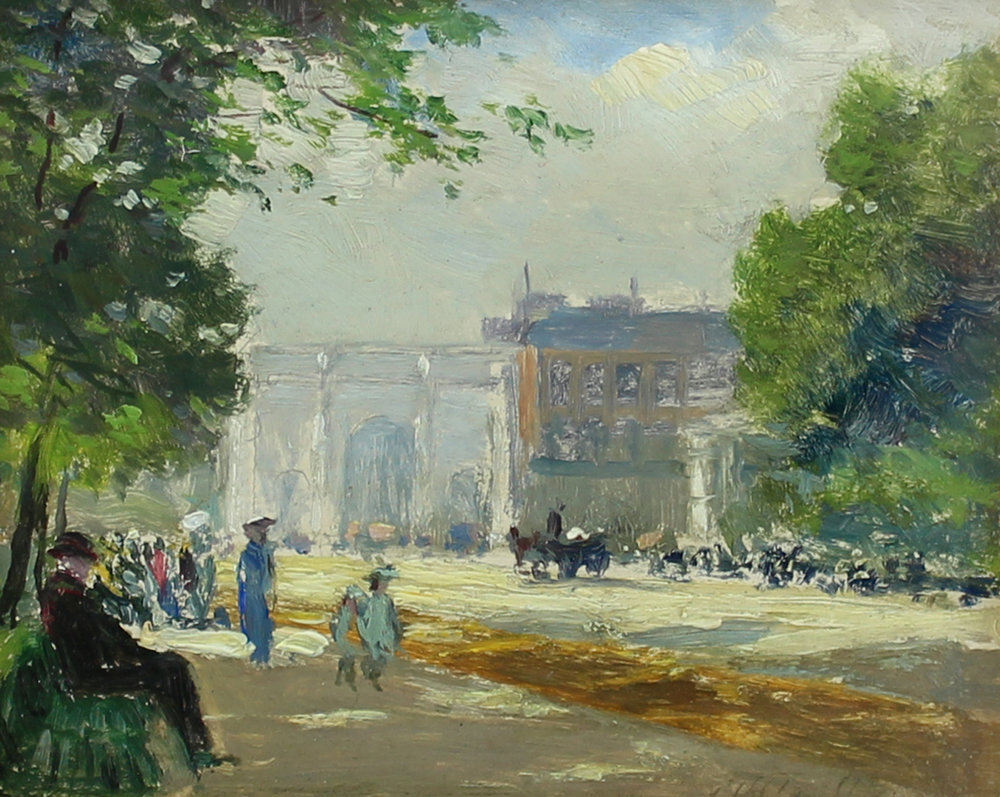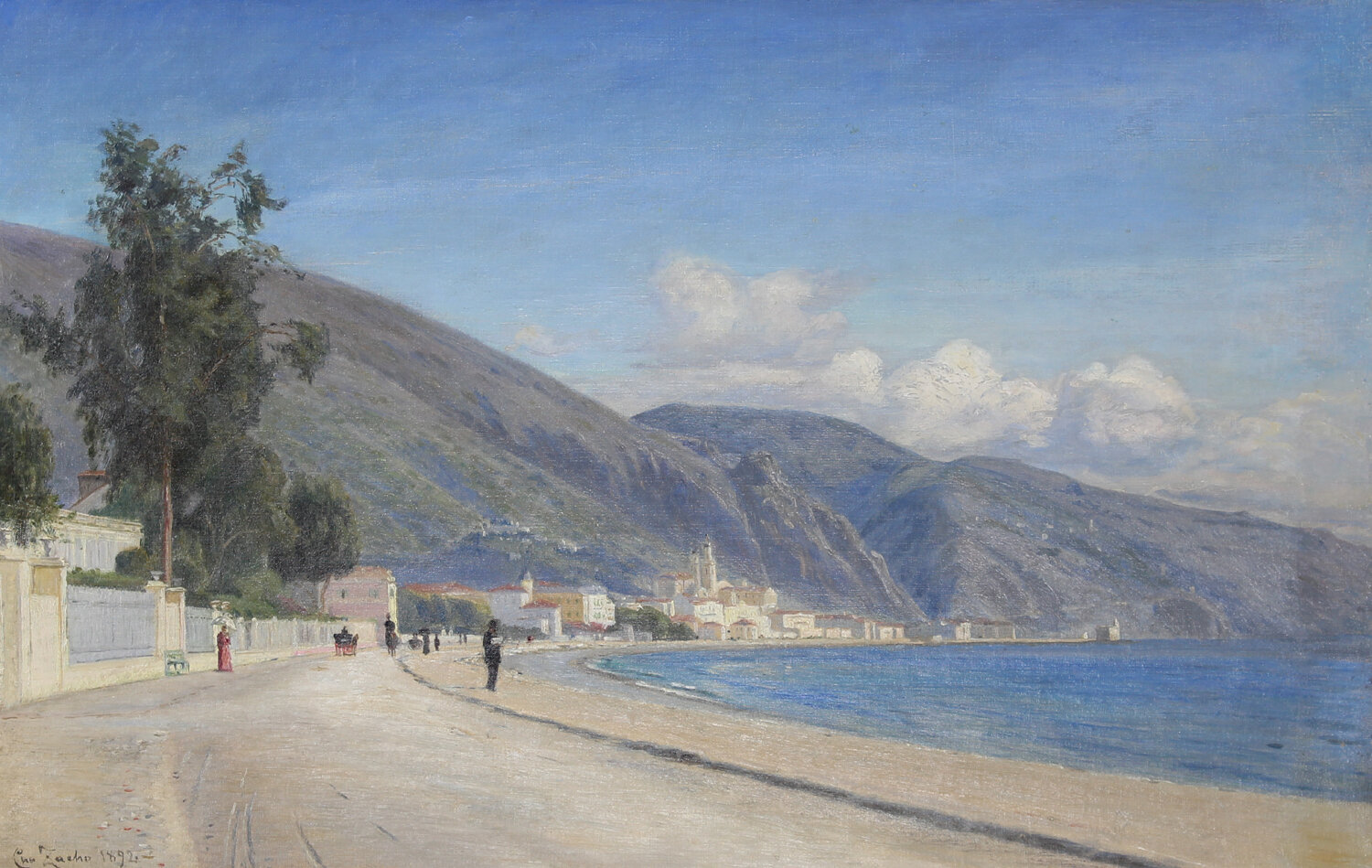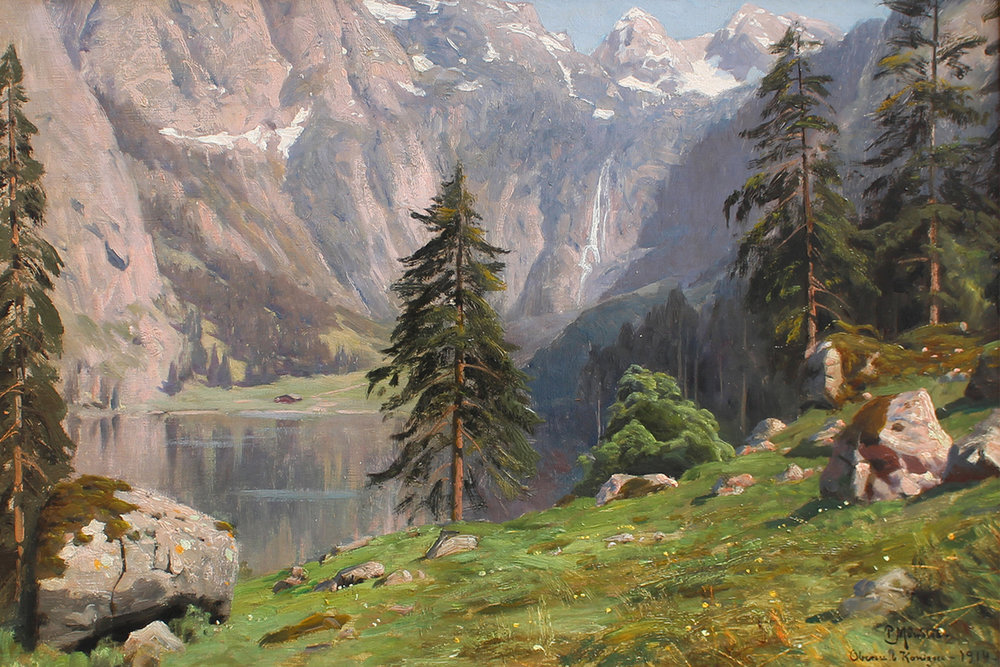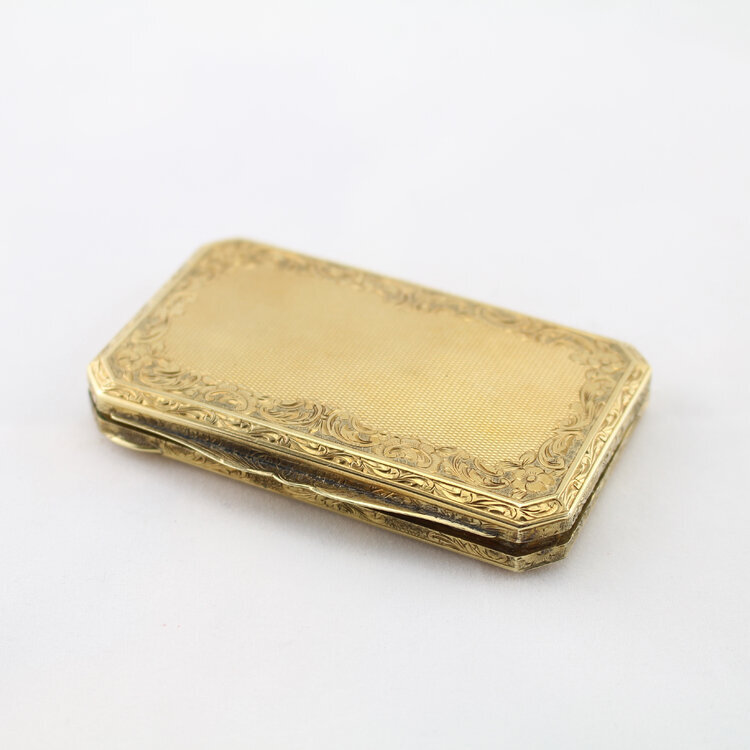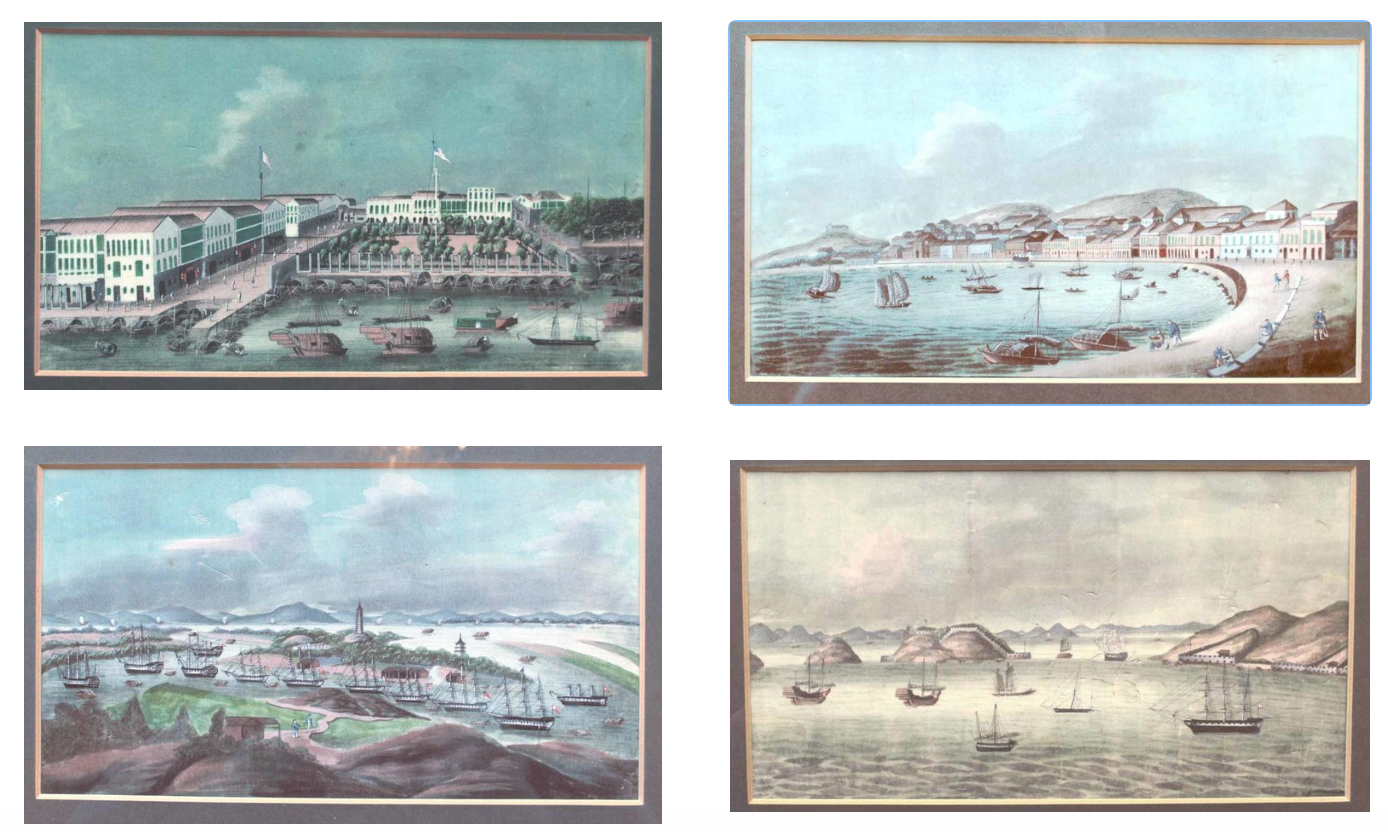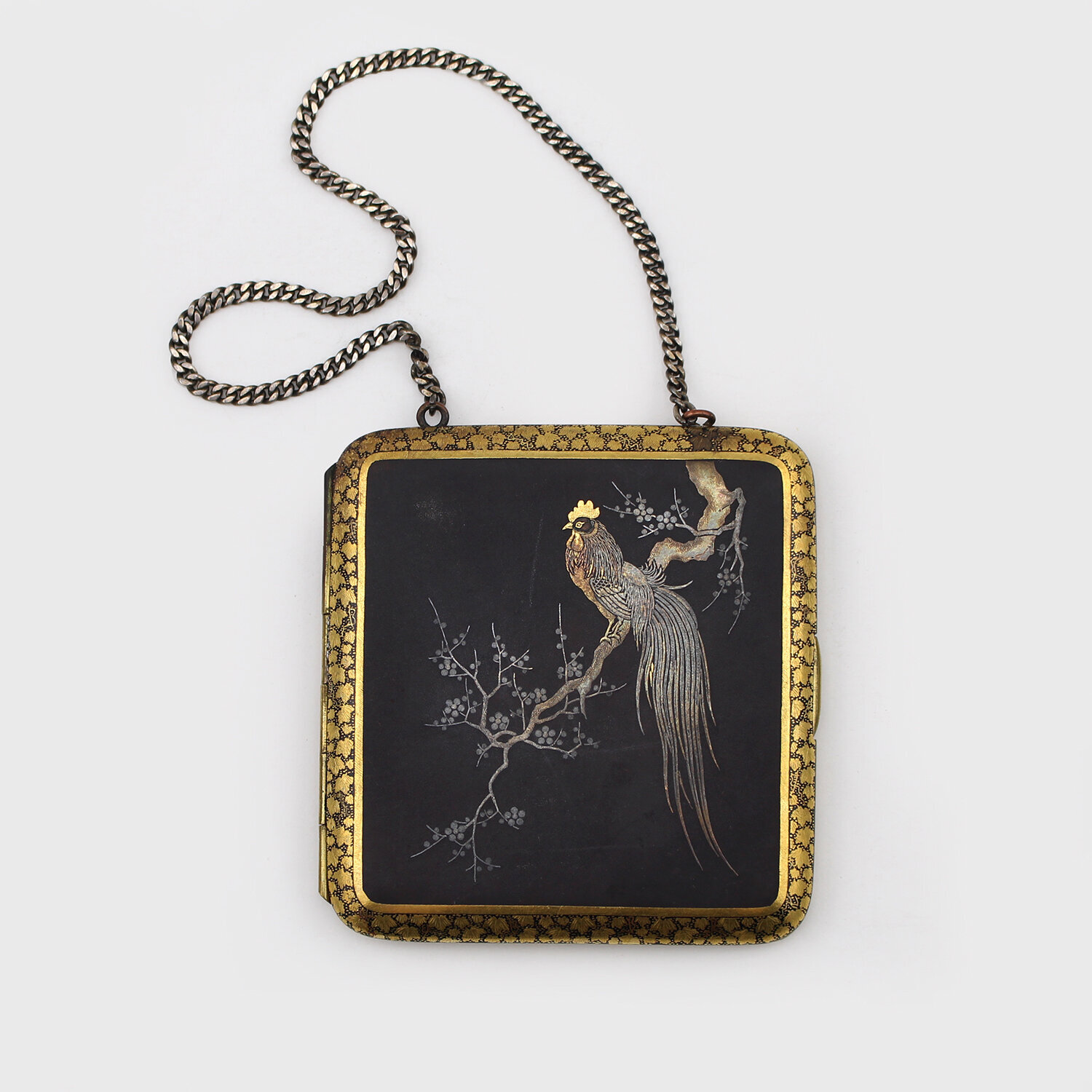WANDERLUST
ONLINE EXHIBITION
We invite you to travel with us around the world through our carefully curated selection of art and antiques. We begin over the pond in the UK, to Scandinavia and through Europe for the Grand Tour, then Down Under and back up through the Orient and to the Arctic,
and finally home to North America.
The Grand Tour
Originating in the 16th century, this Continental journey through Europe down into Italy was a pilgrimage for the children of noble families and often lasted a year or longer. These tours were the basis for many art collections and helped to spread fashion for Neoclassicism and an enthusiasm for Italian painting. Between 1792 and 1815 the French Revolutionary and Napoleonic Wars virtually ended foreign travel,
much like our present time of Covid. By the mid 19th century travel to Europe became easy for the middle class via railway and the time of the Grand Tour ended.
Enjoy these pieces by some of our favourite artists and the stories behind them. We hope this will quench some of your wanderlust thirst!
UNITED KINGDOM
Frederic Marlett Bell-Smith (Canadian 1846-1923)
Hyde Park, London
oil on paper board, signed indistinctly lower right "F.M. Bell Smith", inscribed on reverse on exhibition sticker "Hyde Park London, Eng. By F.M. Bell Smith, R.C.A. exhibited at the R.C.A. 1903"
Size: 4 ½ x 5 ½ in (with frame 10 ½ x 11 ⅝ in)
J16291
Sir John Arnesby Brown (British 1866-1955)
Morston, Norfolk
oil on canvas, signed lower right "Arnesby Brown"
Size: 20 x 24 in (with frame 27 x 31 in)
J18912
James W. Callow (British Fl. 1860)
Harbour Scene
oil on canvas, signed lower left "J.W. Callow" (on stern of boat)
Size: 30 ½ x 45 in (with frame 40 ½ x 55 in)
J16253
Victorian rosewood work box with mother of pearl inlay, the top with a mirror inset into the lid above a fitted work box, with two doors opening to reveal three drawers fitted with jewellery box and writing slant, English circa 1860, with key
Size: 13 h x 12 w x 9 ¼ d in
ZM17889
Charles Edward Dixon (British 1872-1934)
London City View
watercolour, signed and dated "Charles Dixon 95"
Size: 30 x 20 in (with frame 35 ½ x 25 ½ in)
ZJ19580
Irish bog oak figure depicting a man in traditional Irish top hat and suit, mounted on a turned base. Mid 19th century, height 10”. Bog Oak is fossilized wood or peat found in Ireland. The Victorians were fond of carving small articles such as personal or dress ornaments, jewelry or mourning brooches, household ornaments, and functional articles from bog wood. This is an interesting and large example.
Size: 10 ¼ h 3 ¾ in diameter in
M19868
Oval portrait miniature of a lady in gilt frame, with hair locket on reverse
Size: 2 ½ h x 2 w in (3 ¼ height with clasp)
J19155
Portrait miniatures first appeared in European Royal Courts of the 16th century, particularly that of Queen Elizabeth who understood the propaganda power of miniatures. Being small, they could be given personally and on occasion in public ceremonies, as a sign of her favor. As the miniature of herself could be given unframed it was left to the receiver to provide a suitable housing to display her gift.
By the end of the 18th century the popularity of miniatures had spread outside of the Royal courts. Portrait miniature painters were set up in major cities to take advantage of the new trend. In particular, soldiers and sailors sought out having portraits made in order to leave likenesses of themselves with their loved ones while they were absent, and would also commission portraits of loved ones to take with them on their travels. This period saw portrait miniatures worn as jewellery and some would include a memento of hair sealed in the reverse. Portrait miniatures remained the most popular way of capturing a loved one’s image until the development of photography made them obsolete, with the exception of a brief period at the end of the 19th century with the establishment in 1896 of the Royal Society of Miniature Painters.
SCANDINAVIA
Anders Askevold (Norwegian 1834-1900)
Svams-Nosc In Navo Fjord
oil on canvas, signed and dated lower left " A. Askevold daf.1886", inscribed on reverse "Svams-Nosc i navo Fjord" = "Svams-Nosc (boat?) in Navo Fjord (Naeroyfjorden, Norway)"
Size: 19 ¾ x 28 ¾ in (with frame 27 x 36 ½ in)
J19522
Vilhelm Arnesen (Danish 1865-1948)
Copenhagen Harbour
oil on canvas, signed lower left "Vilh. Arnesen 1943"
Size: 30 ½ x 47 ¼ in (with frame 38 x 54 ½ in)
J17440
Carl Frederik Aagaard (Danish 1833-1895)
June Day in the Beech Forest, Lellinge
oil on canvas, signed and dated lower right "C.F. Aagaard 1878"
Provenance:
Exhibited Danish Royal Academy Charlottenborg 1879 #3
Size: 37 ½ x 56 in (with frame 45 ½ x 64 in)
J17278
Viggo Pedersen (Danish 1854-1926)
Coastal Scene From Arild, Sweden
oil on artist cardboard, signed and inscribed lower right "Arild 12 Juli 1912 Viggo Pedersen"
Size: 10 ½ x 15 ¾ in (with frame 18 ½ x 24 in)
J17921
William Blair Bruce (Canadian 1859-1906)
The Stora Sjöfallet Waterfall, Lappland, Solar Eclipse August 9, 1896
oil on canvas on board, signed and dated lower left "W. Blair Bruce 96"
William Blair Bruce met and married the Swedish sculptor Carolina Benedicks in 1888, while on his return to Paris. The young couple subsequently spent their summers in Sweden, eventually establishing an artists’ colony in Gotland. In 1896, the Swedish Tourist Association organized an expedition to experience the August 9 total solar eclipse in the north of Sweden. William and Caroline were among the 13 hardy participants who were housed in a cottage built in 1890 near the waterfall site, which is still in use. In May of 1897, the Swedish Arts Association hosted an exhibition of 130 of Bruce’s paintings including 35 works based on the solar eclipse expedition. It is very likely that The Stora Sjöfallet Waterfall was included in that exhibition.
Susanna Carlston, Chief Curator of the Brucebo Foundation in Gotland, confirms that there are approximately 40 Bruce sketches from the Lappland trip in their collection.
Size: 10 ½ x 13 in (with frame 15 ½ x 18 ½ in)
J19269
Peder M. Monsted (Danish 1859-1941)
Still Water, Summer, 1894
oil on canvas, signed and dated "P. Monsted 1894"
Size: 33 ½ x 49 ½ in (with frame 39 x 56 in)
J19548
HOLLAND
P.C. (Pieter Cornelis) Dommersen (Dutch 1834-1908)
On the Zuiderzee, Holland
oil on canvas, signed and dated "P.C. Dommersen 1897" inscribed on reverse "Kampen on the Zuiderzee Holland" and inscribed on frame "for Claire"
Size: 19 ¼ x 29 ½ in (with frame 26 ½ x 36 ½ in)
J17391
Dommersen established himself as an important figure in the history of marine art with his skillfully executed compositions and uncanny ability to capture atmosphere, be that traumatic seas and stormy skies or the serene waters in a harbour scene. His painting technique combined a mastery of light, shading and depth with an ability to accurately paint figures, ships and water. He also infrequently painted Dutch street scenes, which are quite rare and usually much revered… read more about P.C. Dommersen
Five piece Dutch Delft octagonal garniture set made in De Porceleyne Lampetkan (Delft, Netherlands, 1609-1811), late 18th century (1759 - 1780), including three beaker vases with lion finials and two baluster vases. Each vase has a scrolled flower-cartouche depicting a hunter and his dog against typical Dutch background. The vases are decorated with blue painted foliage all over.
E19702
Garniture sets such as this one are linked to the development of ceramics as a central decorative element in interior design during the 17th century, which saw a frenzy of collecting imported Chinese porcelains. Imported by the Dutch East India company, these luxury goods were snapped up by the European elite as they were seen as a sign of stature and refined taste. Garnitures first appeared in the Netherlands at the end of the 17th century; the Dutch market was introduced through these Chinese ceramics to new shapes, specifically the jar and cylindrical beaker. Often purchased as pairs they would be displayed symmetrically on mantels, above doors or on furniture. These sets kept expanding and gradually evolved into odd number combinations for the visual symmetry. Due to unrest in China the import of Chinese porcelains dropped off, providing Dutch potters the opportunity to fill the market. They began to create pieces in the Chinese style, in sets of three, five, seven and more. It was recorded that Het Moriaenshoot factory designed a set of seventeen, however five was the most common number of pieces, made in a combination of vase forms in matching pairs around a central piece. It is rare to see these sets survive as a whole. In the 18th century we see the development of the Rococo movement and the introduction of rounded shapes and relief scrolls, which coincides with the introduction of serpentine cabinet cornices and wooden consoles designed for the display of these garniture sets.
FRANCE
Claude Emile Schuffenecker (French 1851-1934)
Haystacks
pastel, signed with monogram lower right inscribed on reverse "Collection 20307-4/Room 5"
Size: 12 ½ x 16 ¾ in (with frame 20 ¼ x 24 ¼ in)
J12975
Mogens Vantore (Danish 1895-1977)
Parisian Street Scene
oil on canvas, signed lower left "Vantore, Paris"
Size: 25 ½ x 31 ½ in (with frame 29 ¾ x 35 ½ in)
J19379
Maurice Levis (French 1860-1940)
Landscape with Fisherman
oil on canvas, signed "M. Levis '88"
Size: 17 x 25 ¼ in (with frame 23 x 31 ¼ in)
J15561
Christian Zacho (Danish 1843-1913)
Coastal View from Menton, France
oil on canvas, signed and dated lower left "Chr. Zacho 1892"
Size: 17 x 27 in (with frame 24 x 34 in)
J19135
Paul Desire Trouillebert (French 1829-1900)
Rocky Coastline
oil on canvas, signed lower left "Trouillebert"
Size: 18 x 22 in (with frame 26 ¼ x 29 ½ in)
ZJ16537
GERMANY & SWITZERLAND
Peder M. Monsted (Danish 1859-1941)
Summer Day at Obersee Bei Konigsee
oil on canvas, signed, dated and inscribed "P. Mønsted 1914 Obersee b. Königsee", Obersee is located in Berchtesgaden National Park south of Königsee
Size: 14 x 19 ¾ in (with frame 21 x 26 ¾ in)
J19503
George Clarkson Stanfield (British 1828-1878)
Lake Como
oil on canvas, signed middle right "George C. Stanfield", titled in pencil on stretcher "Lake Como"
Size: 19 ¾ x 30 in (with frame 30 x 40 in)
J18645
Godfred Christensen (Danish 1845-1928)
By Thuner Lake, Switzerland
oil on canvas, "Ved Thuner-søen i Schweitz", signed and dated "Godfred Christensen Thunersø 1878"
Exhibited: Charlottenborg 1878 no. 52.
Size: 35 x 50 in (with frame 47 x 62 in)
J18425
Peder M. Monsted (Danish 1859-1941)
View of Lake, Vevey
oil on board, signed and dated lower right "P. Monsted 1890", inscribed lower left "Vevey"
Size: 6 ¾ x 10 ½ in (with frame 15 ½ x 19 ¼ in)
J14876
French or Austrian gold snuff box of rectangular form, the hinged engine turned covers beautifully engraved with floral motifs around the sides, the edges applied with bands of garlands and floral border, marked 585 (14 K), inscribed "S. Medlinger Wien I Graben 16"
Size: 2 h x 3 ¼ w x ½ d in
R19193
The Viennese building at Graven 16, known as the “Bread House” from its history as an urban bread house in the 14th century. It became a well-known living and dining house which served and entertained the finest society in Vienna as well as prominent guests from abroad. The house was demolished in 1910. Our box is inscribed presumably for its owner “S. Medlinger”, “Wien” for Vienna, and the address for the prominent house “Graben 16”.
Berlin topographical cabinet cup, painted with a view of Dresden with promenading figures, with gilt interior, bottom marked with blue underglaze sceptre Berlin mark, German circa 1820
Size: 2 ¾ h x 3 in diameter
E19139
Masonic glass with engravings, Bohemian, 19th century
Size: 6 h x 2 ½ in diameter in
I384
Masonic lodges have a history of ritual social meetings, incorporating eating and drinking after teachings. Dinners would take place after lodge proceedings ended and would include toasts to the King, Grand Master and visitors, etc. Glasses would be emptied and followed by banging on the table three times - this would necessitate a strong glass with a heavy bottom called a ‘firing glass’. These also became common in military regiments and other fraternal societies in England in the early 18th century. These ritual toasts were spread throughout the world and we find firing glasses being decorated with symbols, names or numbers. These glasses gradually became highly decorative, losing their original function and taking on a more formal role as gifts or rewards.
Bohemian crystal has been internationally recognized for its high quality and craftsmanship of engraving since the Renaissance, and became highly sought after and as precious as jewellery. The region was known for its deer hunting and health spas and visitors from throughout Europe combined hunting trips with a visit to the spas, often for celebrations such as birthdays and special occasions. Known also as ‘spa’ glasses for drinking the water thought to have detoxing benefits, they were brought home for gifts and souvenirs.
Silver Nef ship with a dolphin and cherub embossed hull and two sails, German late 19th century; marked 800 on base
Size: 13 h x 11 ¾ w x 3 d in
C15155
A Table Nef is a small model of a ship made as an elaborate table or sideboard ornament. Primarily made of silver, gilt silver or pure gold, Nefs could also be decorated with enamel or jewels. Nef is the French word for carrack, a type of three or four-masted sailing ship that was developed in the 14th to 15th centuries in Europe. The first table Nef was recorded as early as 1239 in France and initially just consisted of a ship’s hull. It was most likely used as a drinking vessel that then evolved in form to hold the table services and then to hold precious salt or spices. The addition of functional wheels allowed it to be moved along the table for guests to admire it or be served from it. These early Nefs were large and minimal in ornament, but by the 14th century they had evolved to show the full ship with masts, sails and crew. Nefs became so decorated they ceased to be functional and served only for decorative purposes, and often the Nef was placed in front of the guest of honour or the person of highest status as a physical reminder of their position.
ITALY
Peder M. Monsted (Danish 1859-1941)
Fishing, Northern Italy
oil on canvas, signed lower right "P Monsted"
Size: 12 ¼ x 20 ¼ in (with frame 20 ½ x 28 ½ in)
J19721
Hermann David Salomon Corrodi (Italian 1844-1905)
Shrine at Venice, Sundown
oil on canvas, signed and inscribed lower left "H. Corrodi Roma"
Size: 25 ½ x 49 in (with frame 44 ¼ x 58 in)
J19277
Sydney Mortimer Laurence (American 1865-1940)
Venice
oil on pressed board, signed lower right "S M LAURENCE"
Size: 11 ¾ x 17 ½ in (with frame 20 ¼ x 26 in)
J19453
Mary McCrossan (British 1864-1934)
Piazza San Marco, Venice
oil on canvas
Size: 18 ¼ x 24 ¼ in (with frame 22 ½ x 28 ½ in)
J18412
Pair of continental, possibly Italian, alabaster figures on marble bases, circa 1880. Figures are copies of 18th century sculptures, one by Etienne-Maurice Falconet (French 1716-1791) "Bathers" and the other by Christophe-Gabriel Allegrain (French 1710-1796) "Bathers/Venus". Both originals in the Louvre, Paris.
Size: 33 x 10 in (height with pedestals 76 ½ in)
A17380
Jules Noel (French 1815-1881)
View of Constantinople
oil on panel, signed and dated lower right "Jules Noel 1875"
Size: 6 ⅜ x 8 ¼ in (with frame 15 ½ x 17 ½ in)
ZJ17848
Auguste Bouvard/Marc Aldine (French 1882-1956)
San Giorgio Maggiore Island from a Venetian Canal
oil on canvas, signed lower right "Bouvard"
Size: 24 x 32 in (with frame 29 x 38 in)
J19505
Hans Andersen Brendekilde (Danish 1857-1942)
Summer Day, Villa Borghese, Rome
oil on canvas, signed and dated lower left "H. A. Brendekilde Roma 1922"
Size: 20 x 16 in (with frame 25 x 21 ¼ in)
J18574
The most popular park in Rome today, Villa Borghese is located close to the Spanish Steps and Piazza del Popolo. The magnificent estate, with its lush gardens and scenic gravel paths, covers an area of 688 hectares, and is home to the Galleria Borghese and the Rome Zoo. The gardens were developed in 1606, converted from former vineyards into the most extensive gardens in Rome. The Borghese family purchased surrounding lands to expand the estate.
Housed within the Casino Borghese, unquestionably the centerpiece of the Villa, is one of most extensive and venerated collections of ancient, Renaissance, and Baroque art in the world. Galleria Borghese was established by Cardinal Scipione Borghese, nephew of Pope Paul V, who appointed Cardinal Borghese in charge of the Vatican Collection. He became an avid collector and patron to Bernini, creating an extraordinary private collection currently housed in the Galleria. The Villa Borghese was purchased by the Italian state in 1901 and opened to the public in 1903, and is known as the perfect combination between nature and Roman art.
Unusual Sorrento tea caddy, olive wood inlaid with ebony, with original lining, with key, Italian circa 1840
Size in inches: 4 ⅝ h x 5 ⅛ w x 5 ⅛ d
M16928
Since the early 19th century the Italian town of Sorrento has been the center of a thriving marquetry industry. Highly skilled craftsmen create a range of inlay and marquetry work ranging from boxes to wall panels similar to those in the Sorrento Cathedral. Over the years the artform has acquired its own descriptive title: Sorrento Ware.
DOWN UNDER
Samuel Walters (British 1811-1882)
The Frankfield 'Showing her Number' in Rough Seas off Table Bay, Cape Town
oil on canvas, signed and dated lower left "S. Walters 1847"
Size: 28 x 42 in (with frame 33 x 47 in)
J17373
The Frankfield was a full-rigged ship built in New Brunswick in 1840 for Thomas Wilson & Co. of Liverpool for their Australian service. She weighed 750 tonnes and was constructed of black birch, with pine and spruce used internally. She is shown under shortened sail with topsails reefed.
The Frankfield sailed to Australia carrying immigrants to Sydney out of Liverpool, usually carrying about 350 passengers. In 1845-6 she is recorded as sailing to Ichaboe, an island off the Namibian coast of west Africa rich in guano deposits. She is recorded as arriving in Quebec on 9 August 1847, the same year as this painting, carrying 528 passengers under the command of Captain John Robinson. The final reference to her occurs in the Liverpool press in January 1858 where it records "the death of Captain Robinson on 7 December 1847 when his ship Frankfield was wrecked on the East Mouse, Cemaes Bay, Anglesey, in a terrible gale".
This painting could possibly have been a commission by Captain Mitchell to record the vessel's glory days on the Australia run before Mitchell handed her over to captain Robinson.
Frederick F. Schafer (American/Canadian 1839-1927)
The Lake of Everlasting Fire, Sandwich Islands
oil on canvas, signed lower left "F. Schafer", inscribed on reverse "The Lake of Everlasting Fire, Sandwich Islands"
Size: 20 ¼ x 36 in (with frame 28 x 44 ¼ in)
J18723
Captain James Cook named the present day Hawaii the Sandwich Islands after his friend, John Montague, the 4th Earl of Sandwich, upon his first sight of Oahu (January 18, 1778). He recorded the native name as Owyhee.
Carved wooden Oceanic club with incised decoration, weaving on handle, Fijian early 20th century
Size: 25 h x 8 w in
P19869
Hawaiian native umeke (poi feast bowl or calabash) having graceful tapering sides delicately curving in along the rim, 18th century, with extremely fine natural varied light and dark brown patina, with zigzag crack and repair
Size: 7 ¼ in diameter in
P19870
Native to Hawaii and highly revered, Koa wood is legendary for its varied grain pattern and deep rich colour. The word “koa” means “warrior” in Hawaiian; the wood became synonymous with the warriors of King Kamehameha the Great as they used it for their canoes and weapons.So highly regarded was the wood that it was ‘kapu’ (prohibited) for anyone to possess it except the Hawaiian monarchs and Ali’i royalty class. However, after the great king’s death his family abandoned the kapu system allowing all Hawaiians to possess the wood. The prolific wood became used for everyday aspects of early Hawaiian life. Koa was used for cutting and carving instruments for daily living, and food was served in carved out koa bowls called ‘umeke’. The first surfboards were made of koa, as were outrigger canoes and later the settlers introduced the small stringed ‘ukelele’ musical instrument which was almost always made with koa wood.
As Hawaii was developed during the 19th century, large tracts of koa forests were eliminated to make way for grazing cattle. Other livestock introduced to Hawaii, including pigs and goats, would graze on young koa seedlings before they had a chance to mature. Today koa continues to grow on all Hawaiian islands and the rich volcanic soil yields particularly dark and red wood. The most beautiful koa wood, comprising only 10%, has a wavy, fluttering cross-grain pattern called ‘curly’ and is still highly prized . There are strict regulations about the harvesting from only dead and fallen trees and in reforesting koa for future generations.
ASIA
Rare and large Chinese Export painting on silk, depicting trade route, circa 1780
Provenance: Ex Fibiger Collection
ZJ19712
China Coast
Views of Canton, the Tiger's Mouth, Whampoa and Macao
four China Coast watercolours on pith paper, circa 1845, unsigned
(top left) Canton with American and French factories showing the American garden and the waterfront. Size: 6 ¼ x 11 in (with frame 10 ¾ x 15 ¾ in)
(top right) Canton with 'Tiger's Mouth' (the entrance to Canton) with shipping, Size: 5 ½ x 10 in (with frame 10 ½ x 14 ½ in)
(bottom left) Whampoa Reach, with American, French, Danish and British vessels, Size: 6 ¼ x 11 in (with frame 10 ¾ x 15 ¾ in)
(bottom right) Macao Waterfront size 6 1/4 x 11 in (with frame 10 ¾ x 15 ¾ in)
J19176
The rise in trade between China and the West throughout the 18th-century provided the impetus for the establishment of many workshops in Canton making wares for the Western market. These trade wares included porcelain and different pottery objects, lacquer objects, fans and China trade paintings. These paintings were painted on thin paper, silk, mirrors and thinly hammered metal (tin, copper and bronze)… read more about China Coast
Japanese two-tiered lacquer box, circa 19th century
Size: 4 h x 5 ½ w x 4 ½ d in
D14430
Map of Tartary 1588
Map by Abraham Ortelius of China and East Asia (Tartary), coloured copper engraved map of the Tartary by A. Ortelius. Showing large part of Asia from Black Sea with Russia, parts of China, a curious early treatment of Japan and an early treatment of the West Coast of America with California. This map represents the earliest obtainable map to name California. Decorated with two galleons, two large cartouches, a flying fish and several tents. From the 1584 Latin edition of Theatrum Orbis Terrarum, Latin text on verso. Published in Antwerp.
Abraham Ortelius was born 1527 in Antwerp. He studied mathematics, Greek and Latin and traveled+ a lot across Europe. He established a business in dealing with books and drawing maps. His first remarkable map was a 8 sheet world map in the year 1564, but only three copies have survived. In 1570 he issued the Theatrum Orbis Terrarum, the first modern Atlas with uniformly sized maps in a systematic collection. The term Atlas was not used until Mercator introduced it 20 years later. Most of the maps in Theatrum have been engraved by Frans Hogenberg. At the time of publication, the atlas was the most expensive book ever printed. Nevertheless it was a big success and around 7000 copies have been printed until 1612 in many editions and six different languages. Beside the Theatrum, Ortelius compiled a series of historical maps and published it in the Parergon Theatri which was bound with the Theatrum from 1579 onwards or published separately.
Size: 14 x 18 ⅕ in
ZJ19298
Pair of embroidered sleeve bands encased in frame, decorated with forbidden stitch
Size: 27 x 14 ¼ in (with frame 27 ¾ x 15 in)
B19705
The Forbidden Stitch is known as the 'French Knot' or 'Seed Stitch', and also named the 'Peking Knot'. It is rumoured that working this stitch made the seamstress blind therefore the government forbade it, but it is likely that it is named after the Forbidden City. The term refers to small knots stitched on the fabric surface by wrapping a heavy embroidery thread, usually silk floss, around a needle and stitching it down. This is achieved with varying degrees of complexity. The stitch resembles a minute circle and is formed by winding thread around an embroidery needle three or four times, then plunging it through the middle of the coil and fabric form. The stitches are massed together to form decorations (usually in the form of plants, flowers, birds and butterflies) to cover a large area. The stitch was used for exotic costumes and textiles, including lavish robes and lotus foot slippers. The art vanished with the Qing Dynasty in 1911 when these ceremonial items became obsolete.
Fine Japanese Komai style damascene cigarette case of mixed metals, the front decorated with the figure of a bird, the back with butterflies and inscribed with initials "L.M.D", with chain and marked inside with maker's mark, Meiji period circa 1900
Size: 3 ½ h x 3 ¼ w x ¼ d
D19719
RUSSIA
Alexis Harlamoff (Russian 1842-1915)
Portrait of Girl
pencil sketch, signed lower right "A. Harlamoff"
Size: 18 ¼ x 15 in (with frame 22 ¾ x 19 ½ in)
ZJ19473
Russian papier-mache lacquer box with gilded hinges from the Lukutin Factory. Depicting genre miniature of family surrounded by rowan trees. The maker’s mark on the inside places the box in the late 19th century
Size: 2 h x 8 w x 4 ½ d in
M19492
ARTIC
Thomas Harold Beament (Canadian 1898-1984)
Departure for the Hunt
oil on canvas, signed lower left "Harold Beament", included in the Sampson-Matthews oil silkscreens printed in the 1940-1960's
Size: 36 x 42 in (with frame 42 ¼ x 47 ¼ in)
J18591
Along with Lawren Harris and A. Y. Jackson, Beament was one of the first artists to explore the Arctic. He painted Inuit genre scenes in the Canadian North and in 1955 designed a 10-cent stamp for the Canadian Postal Service decorated with an Inuit figure. Later he also made Inuit lithographs for the Queen Elizabeth Hotel in Montreal and many of his works included are in the Sampson-Matthews oil silkscreens printed in the 1940-1960's.
Johannes Kreutzmann (Greenland 1862-1940)
Greenland Figures Skinning A Seal
carved and painted sculpture signed with initials "JK" on foot
Size: 10 ½ h x 16 w x 12 d in
M16822
Johannes Kreutzmann is well known for his carvings of Greenland figures from driftwood painted in strong colours. Kreutzmann’s carvings are very distinctive, particularly by their odd facial expressions and body language. The figures are often represented doing an everyday task or leisure activity. His carvings document how the people lived at the trading stations in the early 20th century. Kreutzmann’s carvings became so popular during his lifetime, that he began to do them by commission request. In 1921 and 1931 several pieces were exhibited at colonial exhibitions in Copenhagen, Rome and Paris, and also at the World’s fair in New York in 1939.
Etulu Etidloie (Inuit Born 1946)
Seated Man with Child
carved soapstone seated male with bent knees wearing a parka with a child.
Provenance: James R. Houston (Jim) Estate
Size: 8 ¼ h x 12 ¾ w x 10 ⅛ d in
ZP19761
UNITED STATES
Peleg Franklin Brownell (Canadian 1857-1946)
St. Kitts, British West Indies
oil on canvas, signed with initials and dated '14 lower right, signed "F. Brownell R.C.A." on reverse
Size: 9 ¼ x 14 in (with frame 17 x 22 in)
J18465
Brownell first visited the Caribbean around 1911, and by 1915 had made several trips to the area and painted approximately forty canvases, watercolours and pastels. Eric Brown, the first director of the National Gallery, was an advocate of Brownell’s work and accompanied him to the West Indies on at least one occasion. It is recognized that his style underwent a significant change after these visits as he was enchanted by the brilliant tropical light and world of exotic textiles. This small body of work is known to be some of his best and most sought after, many being housed in major Canadian institutions.
Frederic Marlett Bell-Smith (Canadian 1846-1923)
The Maine Coast
oil on board, signed lower right "F.M.B.S. 1891"
Size: 12 x 18 in (with frame 23 ½ x 29 ½ in)
J17350
John A. Hammond, Rca, Osa (Canadian 1843-1939)
Gloucester Harbour, Mass.
oil on board, signed and titled on reverse "Gloucester Harbour, Mass. John Hammond $40."
Provenance: Owens Art Gallery Exhibition label 1981The Marshlands Inn, Sackville, NB
Size: 5 ½ x 8 ¼ in (with frame 9 ½ x 12 ½ in)
J17396
Belmore Browne (American/Canadian 1880-1954)
Mountain Landscape
oil on panel, signed lower right "Belmore Browne", numbered on reverse P445
Size in inches: 19 ¼ x 29 ¾ in (with frame 26 x 36 ¼ in)
J19029
Antanas Zemaitis (Lithuanian 1876-1966)
Yellowstone Park, Old Faithful Geyser
oil on canvas, signed lower left
Size: 14 ½ x 18 in (with frame 18 ¼ x 22 in)
J547
An American powder-horn marked Ohio Country 1763 with the date between a moon and sun, carved with towns, animals, lakes. The towns and forts depicted are Detroit, Fort Hamilton, Fort Washington etc.
Provenance: The Aage Brøns collection
Size: 13 in (high)
M19391
CANADA
John Wentworth Russell (Canadian 1879-1959)
Montreal
oil on cradled panel, signed, dated and inscribed lower right "John Russell, Montreal, 1923"
Size: 15 ½ x 18 ½ in ( with frame 20 ⅜ x 23 ½ in)
J18942
Charles John Collings (Canadian 1848-1931)
Sprays at Niagara
watercolour, signed with monogram lower left, inscribed on back of watercolour "Sprays at Niagara"
Size: 7 ½ x 11 in (14 ½ x 18 ½ in)
J19239
Items of use for travelling
Brass carriage clock in fitted leather case, French circa 1870, with white enamel dial and roman numerals, fold down handle, bevelled glass, inscribed "Thoms. Russell & Son, Liverpool, Paris Make", inscribed on movement "France", with key
Size: 6 h x 3 w x 2 ½ d in (with case 5 ½ x 4" x 3 ¾ in)
H19679
Carriage clocks. or ‘Officers’ clocks as they are sometimes known, were first developed for Napoleon Bonaparte between 1798 and 1812 by Abraham-Louis Breguet. The clocks cases are simple in form for ease of transport and are usually made of plain or gilt brass in a rectangular shape with a carrying handle and inset with glass, or on occasion enamel or porcelain panels. The balance spring used to drive the clock replaced the pendulum needed in earlier larger bracket clocks. These small spring-driven clocks were designed for travelling and came encased in leather or leather-covered wood cases which would protect the clock in transport. Often the cases would have fronts which could slide out so the face of the clock could be viewed during transport. It is rare today to find the clock and leather cover intact as time has often deteriorated the leather or the clock and cover have become separated over time. In the past carriage clocks were a traditional gift to retiring or long-serving staff.
19th century strong box with wooden lined interior, with key
Size: 6 ¾ h x 12 w x 7 ½ d in
M18107
Strong boxes were the precursors to today’s safes. They were used to store and safely move money, valuables, and sometime commodities. Often built to be difficult to move singlehandedly to deter theft, they had several other security features. Usually they had false key holes to confuse potential thieves and heavy multi-lock systems that required a large key or keys and pressure to unlock, making them difficult to force. Many had further locked compartments inside. Each feature was designed not only to reduce the threat of theft but also to protect the contents from environmental damage, such as insects or fire. How good they were at protecting from environmental threats is debatable but they did provide more protection for valuables than had been available previously with wooden chests. By the 19th century many strong boxes had become more decorative. They still had a security function, often made of metal to make them difficult to break into, but had become smaller and prettier and were more for display. The 19th century saw the development of the safe and increased availability to banks making strong boxes less necessary.
Augsburg table cabinet, German 17/18th century, decorated with marquetry of indigenous fruitwood and maple and ash depicting architectural scenes and musical instruments. The front drops open to reveal multi-drawers and locked compartments with engraved steel hardware. Comes with 3 keys.
Size: 49 h x 31 w x 15 ¾ d in
A16716
Beginning in the mid-sixteenth century, Augsburg, Germany became one of the leading centres for furniture production and became particularly famous for its fine and intricate marquetry. Cabinetmakers in this south German city specialized in table cabinets intended for the storage of small, precious objects. These luxury cabinets were decorated entirely with colourful marquetry depicting intricate townscapes, classical ruins, animals, figures, and a range of ornamental motifs drawn from contemporary German etchings and engravings.
This fine 17th/18th century example features a drop front which, when opened, reveals eleven drawers and four small doors with intricate, engraved locks. Assembled from various indigenous fruitwood, maple and ash, the cabinet’s surfaces, including the interior drawers and doors, have been decorated with a combination of marquetry and intarsia depicting foliage, musical instruments and architectural scenes of ruins. The green wood used to depict foliage was most likely stained with green fungus. The cabinet has been supported on a matching stand that was created at a later date.


